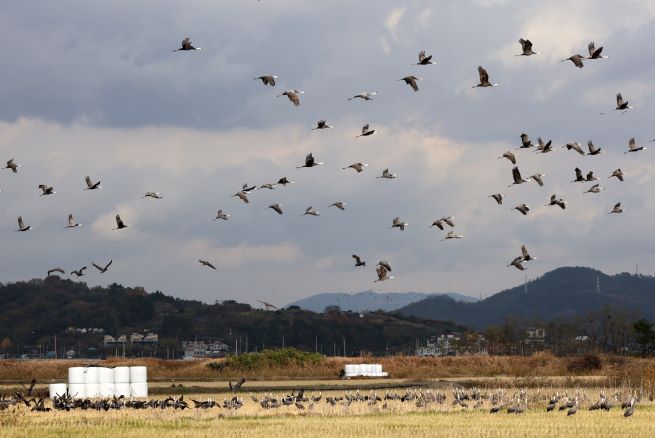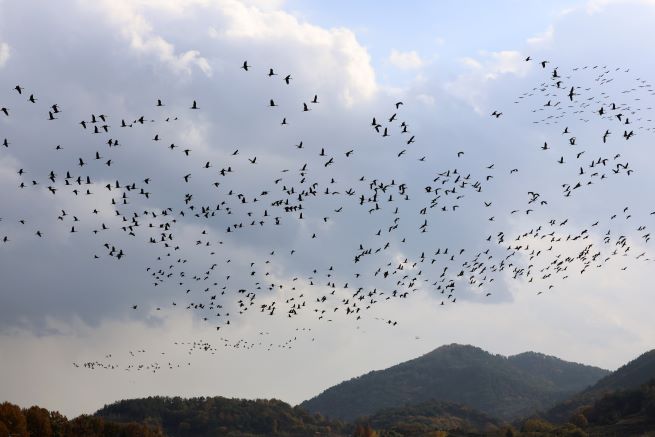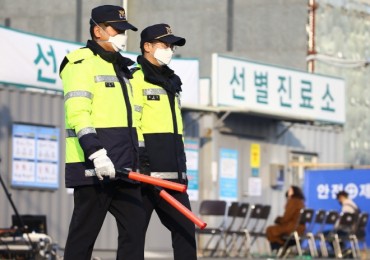
Natural Monument No. 228, the hooded crane, is seen in flight after feeding at Suncheon Bay Wetland in Suncheon City, South Jeolla Province, on November 28. Listed as a Level 2 endangered species, the hooded crane numbered around 400 in Suncheon Bay in 2009. Thanks to continuous migratory bird protection efforts, approximately 7,600 cranes—nearly half of the global population—have been observed at the site this year. (Yonhap)
SEOUL, Nov. 30 (Korea Bizwire) – Suncheon Bay in South Korea has once again become a winter refuge for thousands of hooded cranes, drawing attention to the city’s conservation efforts for these globally significant migratory birds.
As of November 25, local officials reported 6,715 hooded cranes across the bay’s three mudflats: 1,916 in Nongju, 1,555 in Dosadong, and 3,244 in Jangsan.
Every Monday, Suncheon City conducts a meticulous count of the cranes, monitoring their numbers and behaviors. Conservation workers analyze weekly fluctuations, comparing current data to past trends to understand factors influencing population changes.
Hooded cranes, designated as Natural Monument No. 228 in South Korea, are known for their unique habits of gathering in tightly knit groups to protect themselves from predators.
By day, they forage for food in nearby farmland, consuming rice grains, straw, and insect larvae hidden in the soil. At night, they retreat to the mudflats to rest, adjusting their movements with the tides—seeking higher ground during high tide and returning to the flats when waters recede.

Natural Monument No. 228, the hooded crane, is seen in flight after feeding at Suncheon Bay Wetland in Suncheon City, South Jeolla Province, on November 28. Listed as a Level 2 endangered species, the hooded crane numbered around 400 in Suncheon Bay in 2009. Thanks to continuous migratory bird protection efforts, approximately 7,600 cranes—nearly half of the global population—have been observed at the site this year. (Yonhap)
Conservation Through Technology and Dedication
Monitoring these birds is no small feat. At dawn, workers armed with binoculars and drones capture images of the mudflats to document the cranes’ numbers and locations. The process of manually counting the birds in these photos can take hours, prompting staff to eagerly anticipate the integration of AI deep learning technology to streamline the process.
The task is not without challenges. Harsh winter winds and freezing temperatures often render ink unusable, forcing workers to rely on pencils. Despite the conditions, their work continues throughout the season, ensuring minimal disruption to the birds while documenting any disturbances that might affect their feeding or resting patterns.
Rising Numbers and Global Significance
The hooded crane population in Suncheon Bay has seen significant growth over the years, from just 400 birds in 2009 to over 7,200 last year. The spike in numbers in 2022 was attributed to an avian influenza outbreak in Izumi, Japan, which prompted many cranes to seek safety in Suncheon Bay.
This year, the numbers are on track to match or exceed previous records, with 7,600 cranes already counted as of November 9. December through January typically sees the highest concentrations of these birds, which account for nearly half of the global hooded crane population.
A Lesson in Coexistence
Despite the difficulties, Suncheon’s conservation team remains committed. “The biting cold often brings frostbite and illness, but working alongside these cranes teaches us the value of coexistence and the importance of preserving the mudflats,” said a city official on November 28.
As Suncheon Bay continues to serve as a sanctuary for hooded cranes, the city’s efforts exemplify the delicate balance between wildlife conservation and human stewardship, offering a model for preserving biodiversity in the face of global challenges.
Lina Jang (linajang@koreabizwire.com)






